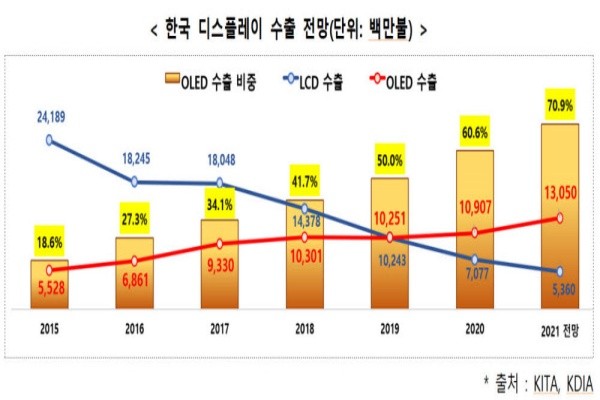It is expected that South Korea’s OLED panel exports in 2021 will be the highest ever in the country’s history as supply of OLEDs has been increasing as many consumers around the world are purchasing TVs and IT devices due to creation of contact-free economies from the COVID-19 pandemic. Particularly, OLED is expected to be solidified as a vital item that is responsible for more than 70% of entire display exports of South Korea.
Process of South Korea’s display industry withdrawing from LCD and transitioning towards new products with high values such as OLED is expected to be much faster. South Korea’s display industry and the South Korean Government plan to accelerate the process and solidify South Korea as the top country in the world when it comes to display.
The Ministry of Trade, Industry and Energy (MOTIE) made a prediction on Wednesday that South Korea’s OLED exports in 2021 would be $13 billion, which is a 19.6% increase from last year, and that they will be responsible for more than 70% of entire display exports in 2021.
If this prediction is true, then South Korea’s OLED exports will almost double in just five years after they brought in $6.8 billion in 2016. Also, OLED exports brought in $10.9 billion last year and broke the $10 billion barrier for three years in a row.
According to a global research market company Omdia, South Korean companies were responsible for 84.9% (based on sales) of the global market for small and medium-sized OLED panels in 2020 and dominated Chinese companies (14.1%) and Japanese companies (0.6%). Particularly, South Korean companies were responsible for 98.1% of the global market for large-sized OLED panels that are bigger than 9 inches.

The MOTIE and the Korea Display Industry Association (KDIA) predicted that this year’s display exports will bring in $18.4 billion that is a 2.4% increase from last year. Their prediction is based on the fact that while LCD exports are starting to decrease, demands for innovative products based on new technologies such as rollable, bendable, foldable, stretchable panels are on a rise.
South Korea’s display industry and the government are accelerating the process of completely shifting their focus from LCD to next-generation displays. Samsung Display and LG Display received approvals from the MOTIE last year regarding their plans for business restructuring. Their plans are centered on having QD display and OLED display as their core businesses respectively. Companies such as LG Chem and others that make materials, parts, and equipment related to displays have also started to withdraw from their LCD businesses.
Minister Sung Yoon-mo of the MOTIE visited LG Display’s exhibition for virtual CES 2021 that is set up at Magok Science Park on Wednesday and encouraged interested parties after looking at future displays.
“We believe that South Korea’s display industry has successfully transitioned towards a structure based on innovative products with high values as the South Korean Government timely approved the business restructuring of the industry.” said Minister Sung. “We are not going to hold back on our resources on development of next-generation displays faster than other countries and mass-production of products based on innovative form factors in order to solidify our country as the top country in the global display market.”
In 2020, display exports brought in $18 billion that is a 12.2% decline compared to 2019. Although the entire amount of display exports decreased due to Chinese companies putting cheap LCDs on the market, South Korea has been able to maintain the top position in the global display market as its OLED industry continued to grow. According to the MOTIE, South Korea is responsible for 37.3% of the global display market. After South Korea, it is China with 36.3%, Taiwan with 21.4%, and Japan with 4.3%.
An official from the MOTIE said that the result is from South Korean companies expanding their premium products including foldable smartphones and OLED TVs and making early actions towards next-generation markets while transitioning from LCD to OLED.
Staff Reporter Yun, Heeseok | pioneer@etnews.com